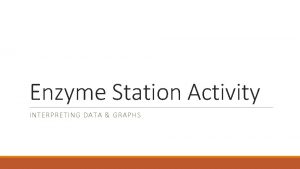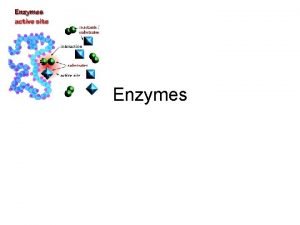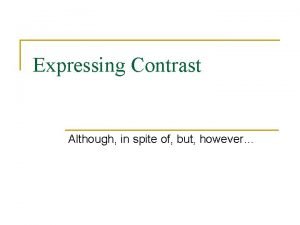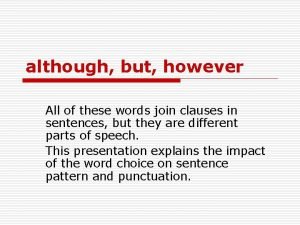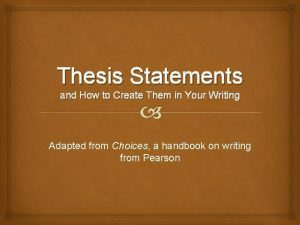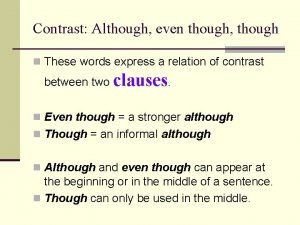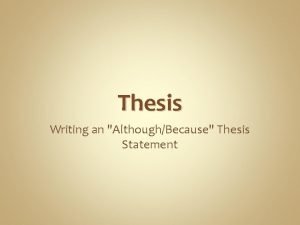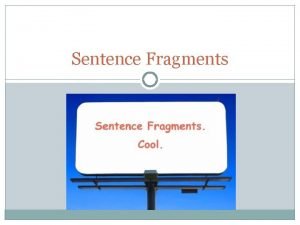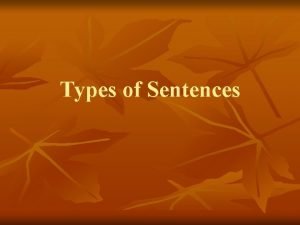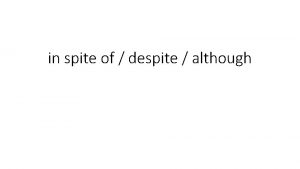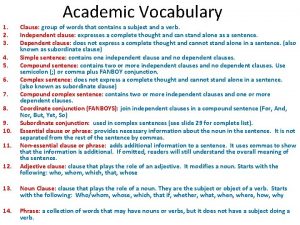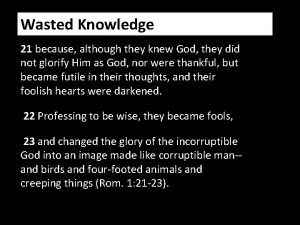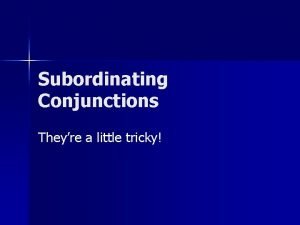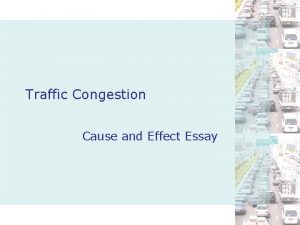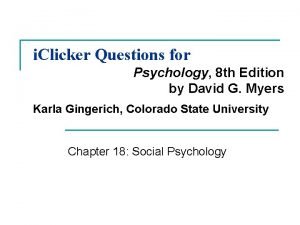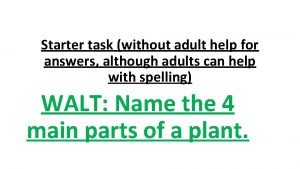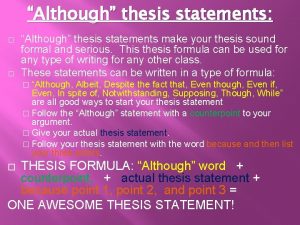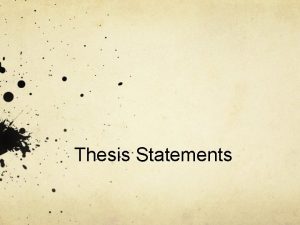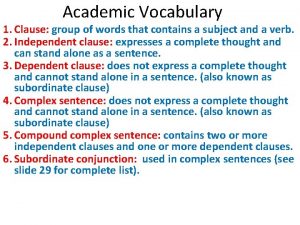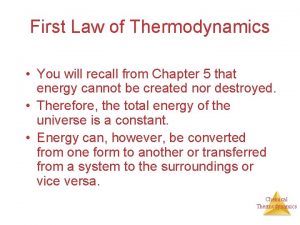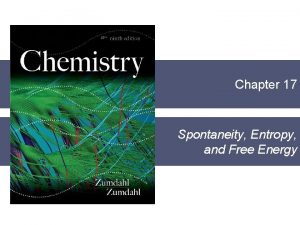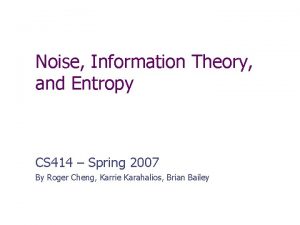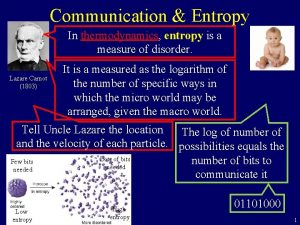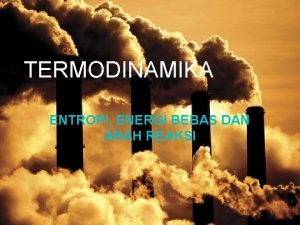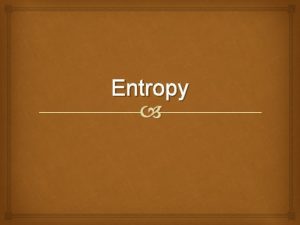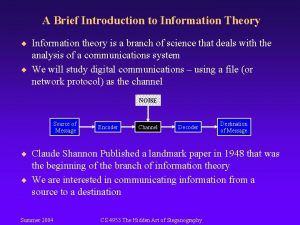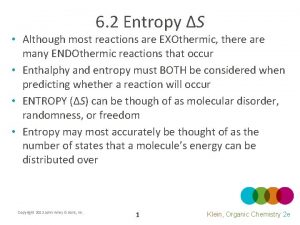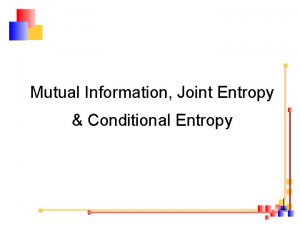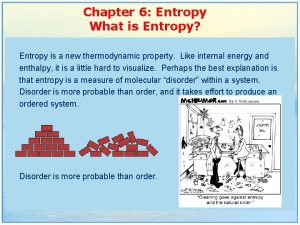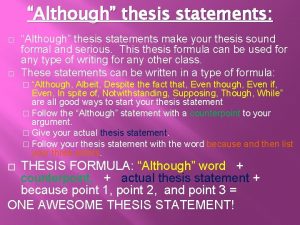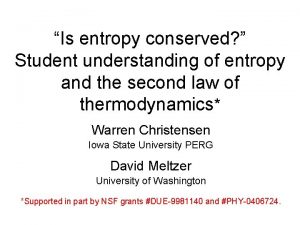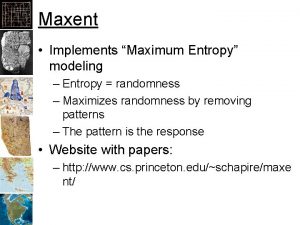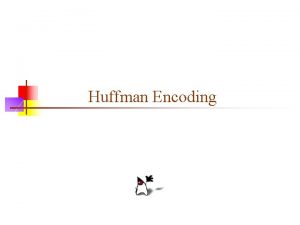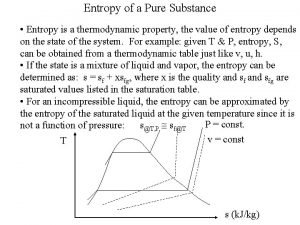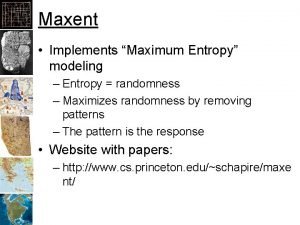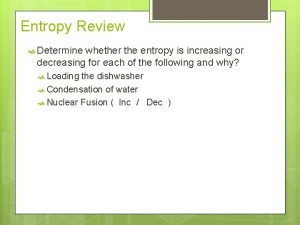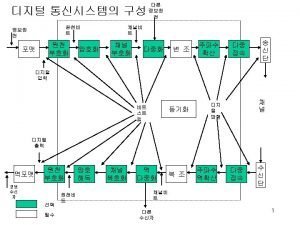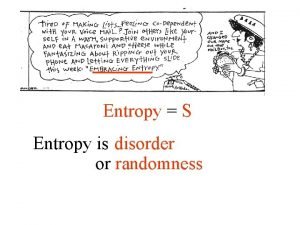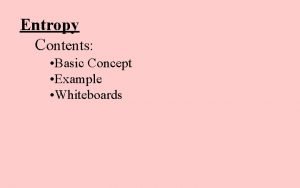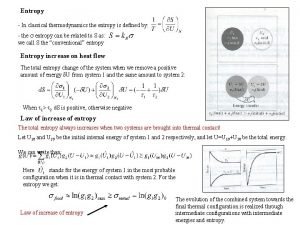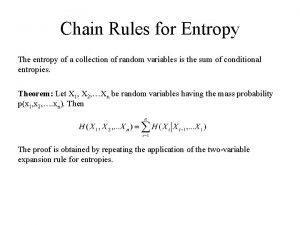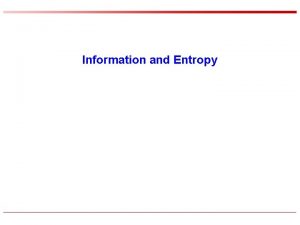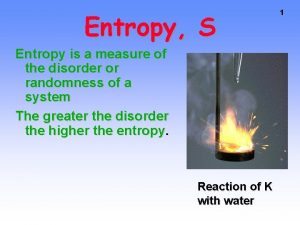6 2 Entropy S Although most reactions are













![6. 4 Equilibria • In any reaction, collisions are necessary • As [A] and 6. 4 Equilibria • In any reaction, collisions are necessary • As [A] and](https://slidetodoc.com/presentation_image/5b8dd913f429b861ea5c439277ec215f/image-14.jpg)



























- Slides: 41

6. 2 Entropy ΔS • Although most reactions are EXOthermic, there are many ENDOthermic reactions that occur • Enthalphy and entropy must BOTH be considered when predicting whether a reaction will occur • ENTROPY (ΔS) can be though of as molecular disorder, randomness, or freedom • Entropy may most accurately be thought of as the number of states that a molecule’s energy can be distributed over Copyright 2012 John Wiley & Sons, Inc. 1 Klein, Organic Chemistry 2 e

6. 2 Entropy ΔS • If the energy of molecules can be distributed in a higher number of vibrational, rotational, and translational states, the sample will have a greater entropy. • Molecules exhibit vibrational, rotational, and translational motion. Explain HOW • Which of the two molecules below should have greater entropy, and WHY? Copyright 2012 John Wiley & Sons, Inc. 2 Klein, Organic Chemistry 2 e

6. 2 Entropy ΔS • Consider the ENTROPY and ENTHALPY change for the following process • The number of possible translational distributions for the molecules increases with increasing volume. HOW? Copyright 2012 John Wiley & Sons, Inc. 3 Klein, Organic Chemistry 2 e

6. 2 Entropy ΔS • The total entropy change will determine whether a process is spontaneous (favors the forward direction) • If ΔStot is positive, the process is spontaneous. What if ΔStot is negative? • For the expansion of a gas, what should the entropy change be for the surroundings? • For chemical reactions, we must consider the entropy change for both the system (the reaction) and the surroundings (the solvent usually) Copyright 2012 John Wiley & Sons, Inc. 4 Klein, Organic Chemistry 2 e

6. 2 Entropy ΔS • For each of the reactions below, predict the sign for ΔSsys • Consider how a change in a molecule’s structure affects the number of possible translational, rotational, and/or vibrational distributions for the molecules? • Why does ΔSsurr depend on ΔHsys? Copyright 2012 John Wiley & Sons, Inc. 5 Klein, Organic Chemistry 2 e

6. 2 Entropy ΔS • How would the following conditions affect spontaneity (the degree to which the reaction is product favored)? 1. The reactions are exothermic 2. The reactions are highly endothermic 3. The reactions are slightly endothermic • Practice with conceptual checkpoint 6. 3 Copyright 2012 John Wiley & Sons, Inc. 6 Klein, Organic Chemistry 2 e

6. 3 Gibbs Free Energy ΔG • We know that the spontaneity of a process depends only on ΔStot • ΔSsys can be measured or estimated • ΔSsurr depends on ΔHsys • Plug in Copyright 2012 John Wiley & Sons, Inc. 7 Klein, Organic Chemistry 2 e

6. 3 Gibbs Free Energy ΔG • Multiply both sides by Temperature » or • How will the sign (+ or -) for ΔG affect spontaneity? Copyright 2012 John Wiley & Sons, Inc. 8 Klein, Organic Chemistry 2 e

6. 3 Gibbs Free Energy ΔG • Consider the example reaction • Predict the sign (+ or -) for ΔSsys • In the reaction, two pi bonds are converted into two sigma bonds. Predict the sign (+ or -) for ΔHsys • Predict the sign (+ or -) for ΔSsurr • Predict the sign (+ or -) for ΔG • How will the spontaneity of the reaction depend on temperature? Copyright 2012 John Wiley & Sons, Inc. 9 Klein, Organic Chemistry 2 e

6. 3 Gibbs Free Energy ΔG • If a process at a given temperature is calculated to have a (-) ΔG, the process is exergonic • It will be spontaneous and favor the products • Note that G is plotted rather than H • Does the value for ΔG tell us about the rate of the reaction? Copyright 2012 John Wiley & Sons, Inc. 10 Klein, Organic Chemistry 2 e

6. 3 Gibbs Free Energy ΔG • If a process at a given temperature is calculated to have a (+) ΔG, the process is endergonic • It will be NONspontaneous and favor the reactants • What does it mean exactly to favor the reactants? • Practice with conceptual checkpoint 6. 4 Copyright 2012 John Wiley & Sons, Inc. 11 Klein, Organic Chemistry 2 e

6. 4 Equilibria • Consider an exergonic process with a (-) ΔG. Will every molecule of A and B be converted into products? – No, an equilibrium will eventually be reached – A spontaneous process will simply favor the products meaning there will be more products than reactants Copyright 2012 John Wiley & Sons, Inc. 12 Klein, Organic Chemistry 2 e

6. 4 Equilibria • Why doesn’t an exergonic process react 100% to give products? Why will some reactants remain? – The diagram shows one unit of A react with one unit of B – In reality, moles of reactants are present – How will concentrations of A, B, C, and D change as the reaction progresses? Copyright 2012 John Wiley & Sons, Inc. 13 Klein, Organic Chemistry 2 e
![6 4 Equilibria In any reaction collisions are necessary As A and 6. 4 Equilibria • In any reaction, collisions are necessary • As [A] and](https://slidetodoc.com/presentation_image/5b8dd913f429b861ea5c439277ec215f/image-14.jpg)
6. 4 Equilibria • In any reaction, collisions are necessary • As [A] and [B] decrease collisions between A and B will occur less often • As [C] and [D] increase, collisions between C and D will occur more often – The more often C and D collide, the more often collisions will occur with enough free energy for the reverse reaction to take place • Recall that equilibrium is dynamic and occurs when the forward and reverse reaction rates are equal Copyright 2012 John Wiley & Sons, Inc. 14 Klein, Organic Chemistry 2 e

6. 4 Equilibria • Equilibrium is also the state with the lowest free energy overall • Why does the equilibrium mixture have the least G? • How would Stot compare for a mixture of A, B, C, and D versus only C and D? Copyright 2012 John Wiley & Sons, Inc. 15 Klein, Organic Chemistry 2 e

6. 4 Equilibria • An equilibrium constant (Keq) is used to show the degree to which a reaction is product or reactant favored • Keq, ΔG, ΔH, and ΔS are thermodynamic terms. They do not describe reaction kinetics. What is the difference? • Practice with checkpoint 6. 6 Copyright 2012 John Wiley & Sons, Inc. 16 Klein, Organic Chemistry 2 e

6. 4 Equilibria • What trends do you notice in table 6. 2? Copyright 2012 John Wiley & Sons, Inc. 17 Klein, Organic Chemistry 2 e

6. 5 Kinetics • Recall that a (-) sign for ΔG tells us a process is product favored (spontaneous) • That does NOT tell us anything about the RATE or kinetics for the process • Some spontaneous processes are fast such as explosions. Can you think of other examples? • Some spontaneous processes are slow such as C (diamond) C (graphite). Can you think of other examples? Copyright 2012 John Wiley & Sons, Inc. 18 Klein, Organic Chemistry 2 e

6. 5 Kinetics • The rate of a reaction tells us how many molecules are reacting in a given period of time • Give some examples for typical reaction rate units • Recall that for reactions to take place, reactants must collide with sufficient force. WHY? Copyright 2012 John Wiley & Sons, Inc. 19 Klein, Organic Chemistry 2 e

6. 5 Kinetics • The reaction rate (the number of collisions that will result in production in a given period of time) is affected by multiple factors 1. 2. 3. 4. 5. The concentrations of the reactants The Activation Energy The Temperature Geometry and Sterics The presence of a catalyst • How will an increase in [reactant] generally affect the reaction rate? WHY? Copyright 2012 John Wiley & Sons, Inc. 20 Klein, Organic Chemistry 2 e

6. 5 Rate Law Equations • To quantify how much the reactant concentration affects the rate of reaction, the Rate Law equation is used • The degree to which a change in [reactant] will affect the Rate is known as the order. • The order is represented by x and y in the Rate Law equation Copyright 2012 John Wiley & Sons, Inc. 21 Klein, Organic Chemistry 2 e

6. 5 Rate Law Equations • Consider a generic reaction that is known to be first order with respect to A and zero order with respect to B: A + B C + D – Write the appropriate Rate Law – How should he rate change if [A] were doubled? – How should he rate change if [B] were doubled? Copyright 2012 John Wiley & Sons, Inc. 22 Klein, Organic Chemistry 2 e

6. 5 Rate Law Equations • Consider a generic reaction that is known to be first order with respect to A and first order with respect to B: A+B C+D – Write the appropriate Rate Law – How should he rate change if [A] were doubled? – How should he rate change if [B] were doubled? Copyright 2012 John Wiley & Sons, Inc. 23 Klein, Organic Chemistry 2 e

6. 5 Rate Law Equations • Consider a generic reaction that is known to be second order with respect to A and first order with respect to B: A+B C+D – Write the appropriate Rate Law – How should he rate change if [A] were doubled? – How should he rate change if [B] were doubled? • How are the orders (exponents) determined for a Rate Law? Copyright 2012 John Wiley & Sons, Inc. 24 Klein, Organic Chemistry 2 e

6. 5 Factors that Affect Rates • Locate the Activation Energy in figure 6. 13? • Why must the free energy (G) increase before the products can be formed? • Why would Eact be different for different reactions? Copyright 2012 John Wiley & Sons, Inc. 25 Klein, Organic Chemistry 2 e

6. 5 Factors that Affect Rates • Temperature is a measure of a system’s average kinetic energy • Would you expect there to be a temperature below which the reaction rate is zero and above which the reaction rate instantaneous? WHY or WHY NOT? Copyright 2012 John Wiley & Sons, Inc. 26 Klein, Organic Chemistry 2 e

6. 5 R Factors that Affect Rates • Why does a lower Eact result in a greater reaction rate? Copyright 2012 John Wiley & Sons, Inc. 27 Klein, Organic Chemistry 2 e

6. 5 Factors that Affect Rates • Why does increasing the temperature increase the rate of reaction? Copyright 2012 John Wiley & Sons, Inc. 28 Klein, Organic Chemistry 2 e

6. 5 Factors that Affect Rates • How might geometry and sterics affect the reaction rate? • How might the presence of a catalyst affect the reaction rate? Copyright 2012 John Wiley & Sons, Inc. 29 Klein, Organic Chemistry 2 e

6. 6 Energy Diagrams • Distinguish between kinetics and thermodynamics Copyright 2012 John Wiley & Sons, Inc. 30 Klein, Organic Chemistry 2 e

6. 6 Kinetics vs Thermodynamics • For the energy diagram below, which pathway do you think is favored? WHY? • Will a decrease in temperature affect which pathway is favored? • Will an increase in temperature affect which pathway is favored? Copyright 2012 John Wiley & Sons, Inc. 31 Klein, Organic Chemistry 2 e

6. 6 Kinetics vs Thermodynamics • For the energy diagram below, which pathway is kinetically favored? • Which pathway is thermodynamically favored? • How can temperature be used to control which set of products predominate? Copyright 2012 John Wiley & Sons, Inc. 32 Klein, Organic Chemistry 2 e

6. 6 Transition States vs Intermediates Copyright 2012 John Wiley & Sons, Inc. 33 Klein, Organic Chemistry 2 e

6. 6 Transition States • A transition state occurs at an energy maxima • Transition states exist for a fleeting moment; they can not be isolated or directly observed • Why are transition states so unstable? Copyright 2012 John Wiley & Sons, Inc. 34 Klein, Organic Chemistry 2 e

6. 6 Intermediates • An intermediate occurs at an energy minima • Intermediates generally exist long enough to observe • Bonds are NOT in the process of breaking or forming Copyright 2012 John Wiley & Sons, Inc. 35 Klein, Organic Chemistry 2 e

6. 6 The Hammond Postulate • Two points on an energy diagram that are close in energy should be similar in structure Copyright 2012 John Wiley & Sons, Inc. 36 Klein, Organic Chemistry 2 e

6. 6 The Hammond Postulate • For each of the diagrams below, will the transition state structure look more like the reactants or the products? Copyright 2012 John Wiley & Sons, Inc. 37 Klein, Organic Chemistry 2 e

6. 6 The Hammond Postulate • Draw a reaction coordinate diagram for the generic exergonic reaction sequence below. Label the axes, reactants, products, intermediates, and transition states A B+C C+D E Net reaction: A + D B + E • How would the diagram look different if it were endergonic? • Practice with conceptual checkpoint 6. 7 Copyright 2012 John Wiley & Sons, Inc. 38 Klein, Organic Chemistry 2 e

Study Guide for sections 6. 2 -6. 6 DAY 12, Terms to know: Sections 6. 2 -6. 6 entropy, vibrational motion, rotational motion, translational motion, spontaneous, free energy, exergonic, endergonic, dynamic equilibrium, equilibrium constant, thermodynamics, kinetics, reaction rate, activation energy, rate law, order of reaction, temperature, transition state, intermediate, Hammond Postulate DAY 12, Specific outcomes and skills that may be tested on exam 2: Sections 6. 2 -6. 6 • Be able to describe three main types of molecular motion. • Given molecular structures, the state of matter, and the temperature, be able to determine which should have greater entropy. • Be able to assess the entropy change for the system, the surroundings, and the universe for given process. • Be able to describe the relationship between the enthalpy change for the system and the entropy change for the surroundings and what impact there is on spontaneity or the degree to which the process is product favored. • Given enough information to determine the change in enthalpy for the system and the change in entropy for the system, be able to determine how a temperature change will affect spontaneity or the degree to which the process is product favored. • Be able to explain why reactions eventually reach equilibrium rather than forming 100% reactants or 100% products based on thermodynamic arguments involving the entropy of the universe. • Be able to explain why reactions eventually reach equilibrium rather than forming 100% reactants or 100% products based on kinetic arguments involving collision theory. • Be able to describe the difference between thermodynamics and kinetics. • Be able to give reasonable units for a reaction rate and describe what reaction rate is. • Be able to list the following factors that affect reaction rate and explain in detail HOW they affect rate: The concentrations of the reactants, The Activation Energy, The Temperature, Geometry and Sterics, The presence of a catalyst. • Given information about how the initial rate changes when the reactant concentration changes, be able to determine the order with respect to that reactant. • Given the order with respect to a reactant, be able to determine how the rate will change when the concentration of a reactant changes. • Be able to explain WHY activation energy is necessary and why some reactions have greater activation energy than others. • Be able to explain how the reaction rate is affected by the magnitude of the Eact. • On a given reaction coordinate diagram, be able to point out the energy differences that affect thermodynamic characteristics of the reaction and what effect temperature changes have. • On a given reaction coordinate diagram, be able to point out the energy differences that affect the kinetic characteristics of the reaction and what effect temperature changes have. • For a reaction coordinate diagram with more than one pathway, be able to predict how a temperature change might favor one pathway over the other (see slide 6 -38). • Be able to explain what is happening during a transition state and how and why that affects the potential energy. • Be able to use the Hammond Postulate to predict something about the structure of a transition state and whether it will look more similar to the reactants or to the products. • Be able to draw a reaction coordinate diagram for a given reaction correctly labeling the chart. • Be able to correctly associate the shape of a reaction coordinate diagram with whether the reaction is exothermic or endothermic or whether the reaction is exergonic or endergonic depending on whether potential energy or free energy is plotted on the y-axis. 39 Klein, Organic. Chemistry 2 e 2 e Klein, Organic

Practice Problems for sections 6. 2 -6. 6 Complete these problems outside of class until you are confident you have learned the SKILLS in this section outlined on the study guide and we will review some of them next class period. 6. 3 6. 4 6. 5 6. 6 6. 7 6. 21 6. 22 6. 23 6. 24 6. 25 6. 26 6. 27 6. 28 6. 29 40 Klein, Organic. Chemistry 2 e 2 e Klein, Organic

Prep for Day 13 Must Watch videos: https: //www. youtube. com/watch? v=O 33 b 6 B 12 Yx. I (nucleophiles and electrophiles) https: //www. youtube. com/watch? v=J 6 wx. MUq 0 WRI (arrow pushing basics) https: //www. youtube. com/watch? v=Aaq 1 qy. Him 6 o, https: //www. youtube. com/watch? v=v-r. HRIk. Bfr 4, https: //www. youtube. com/watch? v=vt 9 Es. Z 0 znl. M, https: //www. youtube. com/watch? v=L 6 Bi 4 gh. Nx. UE, (the 4 basic moves in arrow pushing) https: //www. youtube. com/watch? v=ldnh 3 Snjh 74 (combining the basic moves in arrow pushing) Other helpful videos: https: //www. youtube. com/watch? v=v. VB 5 y. Sj 9 i 4 w (nucleophiles and electrophiles) https: //www. youtube. com/watch? v=VMni. Z 4 pzo. BQ (arrow pushing in detail) http: //ps. uci. edu/content/chem-51 a-organic-chemistry (lecture 21) Read sections 6. 7 -6. 12 41 Klein, Organic. Chemistry 2 e 2 e Klein, Organic
 Mikael ferm
Mikael ferm Chemical reactions section 3 reactions in aqueous solutions
Chemical reactions section 3 reactions in aqueous solutions Section 2 classifying chemical reactions worksheet answers
Section 2 classifying chemical reactions worksheet answers Unit 5 chemical reactions answers
Unit 5 chemical reactions answers How to write redox half reactions
How to write redox half reactions Section 2 classifying chemical reactions worksheet answers
Section 2 classifying chemical reactions worksheet answers What variables affect enzyme activity in each of the graphs
What variables affect enzyme activity in each of the graphs Will amylase build keratin out of peptides
Will amylase build keratin out of peptides Though i walk
Though i walk Although in a sentence
Although in a sentence Even though we walk in the flesh
Even though we walk in the flesh How to use however
How to use however Negative linking words
Negative linking words Although thesis statement
Although thesis statement Thoughn
Thoughn Eating habits in czech republic
Eating habits in czech republic Although thesis statement
Although thesis statement Although he had been an often decorated soldier
Although he had been an often decorated soldier Area in a sentence
Area in a sentence Despite although
Despite although Quia conjunctions rags to riches
Quia conjunctions rags to riches My hogs by kayla afinson
My hogs by kayla afinson Knowledge not shared is wasted
Knowledge not shared is wasted Subjunksjoner
Subjunksjoner Causes of traffic congestion essay
Causes of traffic congestion essay Coordinating conjunction swabi
Coordinating conjunction swabi Bart complied with his friends
Bart complied with his friends Although
Although Although thesis statement
Although thesis statement The moon is faithful although blind
The moon is faithful although blind Although nobody can prevent
Although nobody can prevent What s a thesis statement
What s a thesis statement Older television sets had tubes
Older television sets had tubes Physical science chapter 6 review answers
Physical science chapter 6 review answers Molar entropy trends
Molar entropy trends Entropy of the universe
Entropy of the universe Entropy
Entropy Yeytex
Yeytex Entropy in verbal communication
Entropy in verbal communication Nilai entropi propana
Nilai entropi propana Is entropy a state function
Is entropy a state function Entropy information theory
Entropy information theory






